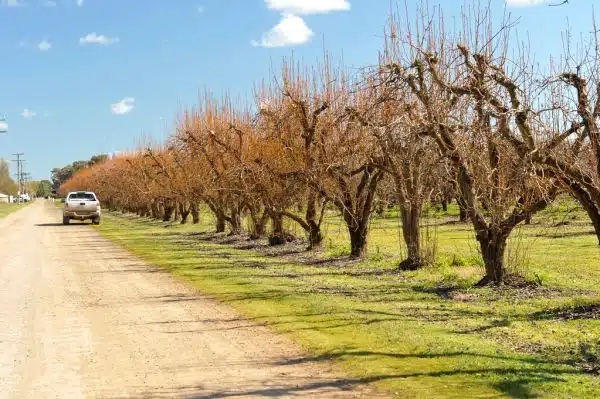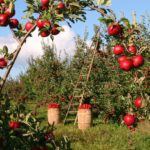Bartlett pear trees, also known as Williams pear trees, are a popular fruit tree that can be grown in home gardens or commercial orchards. These trees produce juicy and sweet pears that are perfect for eating fresh, canning, or baking into delicious desserts. Growing Bartlett pear trees requires proper planning and care to ensure a healthy and productive tree.
In this article, we will discuss the steps required to successfully grow Bartlett pear trees. From selecting the right location to planting and caring for your tree, we will provide you with expert advice on how to achieve optimal growth and harvest from your Bartlett pear tree. Whether you are an experienced horticulturist or just starting out, this guide will equip you with the knowledge necessary to cultivate a thriving Bartlett pear tree in your backyard.
Understanding The Bartlett Pear Tree
The Bartlett pear tree, also known as the Williams pear tree, is a popular fruit-bearing tree among gardeners and farmers alike. Its sweet and juicy fruits are highly sought after in the market, making it a lucrative crop for many growers. Understanding pollination is crucial when growing this variety of pear trees. The Bartlett pear tree is not self-pollinating, which means that it needs another cultivar of the same species nearby to produce fruit.
One common mistake that many people make is confusing the Williams pear tree with the Bartlett pear tree. Although they share some similarities, these two cultivars have distinct differences that set them apart from each other. The Williams pear tree has a slightly more elongated shape than the Bartlett, with a greenish-yellow skin that often turns red when ripe. On the other hand, the Bartlett pear has an egg-shaped appearance with smooth yellowish-green skin.
To maximize fruit production and ensure successful growth of your Bartlett pear tree, it’s important to know these key distinctions between different cultivars and their pollination requirements. By choosing the right companion cultivar for your Bartlett pear tree and placing it in an appropriate location, you can enjoy bountiful harvests of delicious fruits for years to come.
Choosing The Right Location
One of the most important factors to consider when growing Bartlett pear trees is choosing the right location. These trees require a lot of sun exposure in order to thrive, so it’s important to select a spot that gets at least six hours of sunlight per day. Ideally, you should choose a location that receives full sun for the majority of the day.
In addition to sun exposure, soil type is also an important consideration when growing Bartlett pear trees. These trees do best in well-drained soils with good fertility. Avoid planting them in heavy clay soils or poorly drained areas, as this can lead to root rot and other issues. Instead, look for a location with loamy or sandy soil that drains well.
By choosing the right location for your Bartlett pear tree, you’ll be setting it up for success from the very beginning. Remember to prioritize sun exposure and soil drainage when selecting your planting site. In the next section, we will discuss how to prepare your soil for optimal growth and productivity.
Soil Preparation For Optimal Growth
Soil quality is essential for optimal growth of bartlett pear trees (williams pear trees) as it provides the foundation for the tree to take up nutrients and water. The soil should be well-drained and contain a balanced nutrient content, including adequate amounts of nitrogen, phosphorus, and potassium. An appropriate pH level should be maintained, as too acidic or basic soil conditions can prevent the uptake of essential nutrients. Furthermore, watering frequency should be adapted to the soil moisture content and climate of the region, as too much or too little water can both impede the growth of the tree. Thus, soil preparation is a key factor for successful growth of bartlett pear trees.
Soil Quality
To grow healthy and fruitful Bartlett pear trees, soil quality is a crucial aspect that requires careful consideration. One of the most important factors to consider when preparing soil for optimal growth is improving drainage. Poorly drained soils can lead to stagnant water, which can cause root rot and other diseases. Therefore, it’s recommended to add organic matter such as compost or well-rotted manure to improve soil structure and increase water infiltration.
In addition to improving drainage, proper nutrient management is also essential for growing healthy Bartlett pear trees. Soil testing can help determine the nutrient content of the soil and identify any deficiencies or imbalances. Based on the test results, appropriate fertilizers can be applied in the correct amount and at the right time to ensure optimal growth.
It’s worth noting that Bartlett pear trees prefer slightly acidic soils with a pH range of 6.0-7.0. Therefore, liming may be necessary if the soil pH is too low. Overall, by improving drainage and managing nutrients properly, one can create a favorable environment for Bartlett pear trees to thrive and produce abundant fruit.
Nutrient Balance
As a horticulturalist, soil preparation is one of the most crucial aspects when growing healthy and fruitful Bartlett pear trees. In addition to improving drainage, nutrient management is also essential to ensure optimal growth. Soil testing can help determine the nutrient content of the soil and identify any deficiencies or imbalances that need to be addressed.
Balancing pH levels is an essential aspect of nutrient management. Bartlett pear trees prefer slightly acidic soils with a pH range of 6.0-7.0. If the soil pH is too low, liming may be necessary to bring it up to the desired range. On the other hand, if the pH level is too high, it can lead to micronutrient deficiencies, such as iron and manganese, which can negatively impact tree growth and fruit production.
Thus, balancing nutrient levels is critical for maintaining soil health and preventing micronutrient deficiencies. It’s essential to apply appropriate fertilizers in the correct amount and at the right time based on soil test results. By managing nutrients properly and addressing any imbalances or deficiencies effectively, one can create a favorable environment for Bartlett pear trees that allows them to thrive and produce abundant fruit.
Watering Frequency
Another crucial aspect of soil preparation for optimal Bartlett pear tree growth is proper watering methods. The frequency and amount of water given to the trees can significantly affect their health, growth, and fruit production. Bartlett pear trees are moderately drought-tolerant but still require consistent moisture to thrive.
To determine the appropriate watering frequency, it’s essential to consider factors such as soil type, weather conditions, and tree age. Younger trees may require more frequent watering than mature ones. A general rule of thumb is to water deeply once a week during dry spells or when there is insufficient rainfall. Overwatering can lead to root rot and other plant diseases, while under-watering can cause stress and reduced fruit yield.
Mulching is an effective way to retain moisture in the soil and reduce the frequency of watering needed. Adding a layer of organic mulch around the base of the tree helps regulate soil temperature, prevent weed growth, and improve soil structure. It also helps retain moisture in the soil by reducing evaporation from the surface. By using appropriate watering methods such as mulching and deep watering practices, you can help maintain healthy Bartlett pear trees that produce abundant fruit year after year.
Planting Your Bartlett Pear Tree
After preparing the soil, it is time to move on to planting your Bartlett pear tree. Did you know that proper spacing techniques are crucial for optimal growth? These trees require enough space between them to ensure they receive adequate sunlight and access to nutrients. For example, if you are planting more than one tree, make sure there is at least 20 feet of space between each tree.
Sunlight management is also important for the healthy growth of your Bartlett pear tree. These trees prefer full sun exposure, meaning they should receive at least six hours of direct sunlight per day. In areas with hot summers, it may be beneficial to provide some shade during the hottest parts of the day to prevent sunscald on the bark and fruit.
Now that you have planted your Bartlett pear tree using proper spacing techniques and sunlight management, it is time to discuss watering needs and techniques. Proper watering is essential for establishing young trees and ensuring their overall health. Stay tuned for our next section where we will dive into everything you need to know about watering your Bartlett pear tree.
Watering Needs And Techniques
- Watering frequency for bartlett pear trees (williams pear trees) should generally occur once per week during the spring and summer months.
- To ensure best results, irrigation should consist of slow and deep watering sessions as opposed to light and frequent ones.
- Appropriate irrigation types for bartlett pear trees include drip irrigation and flood irrigation.
- The soil moisture level of the root zone should be monitored regularly to ensure the tree is not stressed from over or under watering.
- To maintain a healthy soil moisture level, soil should be tested for moisture content on a regular basis.
- It is important to adjust irrigation frequency or duration as needed to maintain an optimal soil moisture level for bartlett pear trees.
Watering Frequency
To ensure healthy growth and fruit production in Bartlett pear trees, proper watering techniques must be employed. Watering frequency is a crucial aspect of watering needs that should not be overlooked by horticulturists. The frequency at which Bartlett pear trees require watering depends on several factors, including soil moisture levels, weather conditions, and tree age.
Young Bartlett pear trees typically require more frequent watering than mature trees. Newly planted trees should be watered at least once a week during the growing season to maintain soil moisture levels that promote root growth. As the tree matures and its roots expand, it becomes more drought-tolerant and requires less frequent watering. However, even mature trees need to be watered regularly during periods of drought or high temperatures to prevent stress and maintain fruit quality.
When determining the appropriate watering technique for Bartlett pear trees, horticulturists should consider the soil type and texture. Soil with high clay content retains moisture better than sandy soil types, thus requiring less frequent watering. In contrast, sandy soil types drain water quickly and require more frequent irrigation to maintain adequate soil moisture levels. Horticulturists can use a soil probe or moisture meter to assess soil moisture levels accurately and adjust their watering frequency accordingly. By adhering to these guidelines, horticulturists can ensure healthy growth and fruitful harvests from their Bartlett pear trees for years to come.
Irrigation Types
Effective irrigation is essential to maintain healthy Bartlett pear trees. Horticulturists must consider the appropriate irrigation types that will deliver water efficiently and accurately to the trees’ root zones. Drip irrigation and sprinkler irrigation are two popular methods that horticulturists can use to irrigate their Bartlett pear trees.
Drip irrigation is a low-pressure system that delivers water directly to the tree’s root zone, reducing water loss through evaporation and runoff. This method uses tubing with small emitters or drippers placed at specific intervals along the tree’s drip line. The slow, consistent delivery of water ensures that soil moisture levels remain consistent, promoting healthy root growth and reducing the risk of disease.
Sprinkler irrigation, on the other hand, uses overhead sprinklers to deliver large volumes of water above ground. This method is ideal for mature Bartlett pear trees with extensive root systems that require deep watering. Sprinkler systems can be automated to irrigate trees at specific times or manually operated as needed based on weather conditions.
In conclusion, choosing the appropriate irrigation type is critical in maintaining healthy Bartlett pear trees. Drip irrigation delivers water directly to the root zone while minimizing wastage through evaporation and runoff. In contrast, sprinkler irrigation is useful in watering mature trees with deep-rooted systems needing large volumes of water. By using these techniques appropriately, horticulturists can ensure optimal fruit production in their Bartlett pear trees.
Soil Moisture Levels
Maintaining optimal soil moisture levels is crucial in ensuring the health and productivity of Bartlett pear trees. Soil moisture refers to the amount of water held in the soil that is available for plant uptake. Adequate soil moisture ensures that the trees receive enough water to support their growth and fruit production. Horticulturists must, therefore, monitor soil moisture levels regularly and use appropriate watering techniques to maintain optimal levels.
The frequency of watering depends on various factors such as climate, soil type, and tree age. Young trees require more frequent watering than mature ones since they have shallow root systems that dry out quickly. During hot and dry weather conditions, horticulturists should increase watering frequency to prevent stress on the trees. Proper drainage solutions should also be implemented to avoid overwatering, which can lead to root rot and other diseases.
To ensure adequate soil moisture levels, horticulturists can use various techniques such as drip irrigation or sprinkler irrigation. Drip irrigation is ideal for maintaining consistent soil moisture levels while minimizing water wastage through evaporation and runoff. On the other hand, sprinkler irrigation is useful for mature trees with deep-rooted systems that require deep watering. Horticulturists can automate these systems or manually operate them based on weather conditions to ensure optimal soil moisture levels for their Bartlett pear trees.
Fertilizing For Maximum Yield
Fertilizing your bartlett pear trees is essential in maximizing the yield of your harvest. Organic fertilizers are a great option to provide nutrients to your trees while also maintaining soil health. These fertilizers include compost, manure, and bone meal. They release nutrients slowly over time and improve soil structure, which can lead to better water retention and drainage.
If you prefer synthetic fertilizers, it is important to choose a balanced fertilizer with equal amounts of nitrogen, phosphorus, and potassium (N-P-K). These fertilizers can provide an immediate release of nutrients that can improve tree growth and fruit production. Be cautious not to over-fertilize your trees as this can lead to excessive growth or even damage them.
It is recommended to fertilize your bartlett pear trees twice a year – once in early spring before new growth appears and again in late summer after fruiting has occurred. Be sure to follow the instructions on the package carefully when applying fertilizer. Remember that fertilizer is only one part of proper tree care; proper watering, pruning, and pest control are also crucial for healthy tree growth. In the next section, we will discuss how pruning and training your tree can further improve its overall health and productivity.
Pruning And Training Your Tree
As a horticulturalist, one of the most important aspects of growing healthy and productive Bartlett pear trees is proper pruning and training. Pruning is a necessary practice that involves removing certain parts of the tree to promote better growth, fruit production, and overall health. Training refers to the process of shaping the tree in a specific manner to optimize its productivity.
Summer pruning is an essential technique used to control excessive growth by selectively removing some of the new shoots. This method helps prevent overcrowding and increases air circulation within the tree canopy, reducing the risk of fungal diseases. On the other hand, winter pruning involves using an open center method that removes central branches from young trees. This encourages outward growth and sunlight penetration since pears require ample sun exposure for optimal fruit production.
The espalier technique is another useful training method that involves training trees on a trellis or wall to create a flat pattern with multiple branches in a horizontal position. It allows maximum exposure to sunlight while minimizing space requirements for planting. These techniques help enhance Bartlett pear tree productivity while maintaining their overall health. In the next section, we will delve into pest and disease management strategies that can help protect your trees from common threats like fire blight and codling moth infestation.
Pest And Disease Management
Pest and Disease Management:
Growing healthy Bartlett pear trees requires careful attention to pest and disease management. Pests such as aphids, mites, and codling moths can damage fruit and weaken the tree over time. Diseases like fire blight, powdery mildew, and black spot can also cause significant damage to the tree.
One effective approach to managing pests and diseases is through Integrated Pest Management (IPM). This approach combines preventive measures such as regular inspections for signs of pests or disease, proper pruning techniques to improve air circulation, and maintaining soil fertility. Organic solutions are also a key part of IPM. These include using natural predators like ladybugs or lacewings to control pests, planting companion plants that deter pests, and using organic sprays made from plant extracts or essential oils.
By incorporating these practices into your orchard management plan, you can effectively manage pests and diseases while minimizing the use of harmful chemicals. In the next section, we will discuss how to know when your pears are ready for harvest.
Harvesting Your Bartlett Pears
After successfully managing pests and diseases that can harm Bartlett pear trees, it’s time to think about harvesting the fruits of your labor. But how do you know when it’s time to pick your pears? One way is to check for maturity by gently twisting a fruit on the tree. If it comes off easily, it’s ready for harvest. Another way is to monitor the color change of the fruit from green to yellow. Once the skin has turned yellow and there is a slight give when squeezed, it’s time to pick.
When harvesting Bartlett pears, be gentle and avoid dropping them as this can cause bruising which affects their quality. Additionally, avoid pulling or tugging on the stems as this can damage the tree and affect future production. Instead, use picking techniques such as gently lifting and twisting the fruit off its stem or using pruning shears to cut just above where the stem meets the branch.
Once harvested, Bartlett pears will continue to ripen off the tree at room temperature within a few days. To speed up the ripening process, place them in a paper bag with an apple or banana which releases ethylene gas that accelerates ripening. Once ripe, store them in a cool place such as a refrigerator where they can last for several weeks. With these tips, you’ll be able to enjoy your delicious Bartlett pears long after harvest season has ended.
Transitioning into the subsequent section about storing and preserving your pears: Proper storage is key in ensuring your Bartlett pears stay fresh for as long as possible. Let’s take a closer look at how you can store and preserve your harvest so you can always have access to delicious homegrown fruit.
Storing And Preserving Your Pears
Once your Bartlett pear trees have produced their sweet, juicy fruit, it’s important to properly store and preserve them to ensure maximum enjoyment. Storing tips include keeping pears in a cool, dry place, such as a root cellar or refrigerator at around 30-35°F. Pears should also be stored separately from other fruits and vegetables as they emit ethylene gas which can cause premature ripening and spoilage.
Preserving techniques for pears include canning, freezing, and dehydrating. Canning involves packing the pears in jars with syrup and processing them in boiling water. Freezing requires blanching the pears first before placing them in freezer bags or containers. Dehydrating involves slicing the pears thinly and drying them until they are leathery but not brittle.
Properly storing and preserving your Bartlett pears will allow you to enjoy their delicious flavor throughout the year. Whether you choose to can, freeze, or dehydrate your pears, following these techniques will ensure that they remain fresh and flavorful for months to come. If you do encounter any issues with your storage or preservation methods, there are some common troubleshooting strategies that can be employed to salvage your crop.
Common Issues And Troubleshooting
As a horticulturalist, it is important to prepare for and prevent any issues that may arise when growing bartlett pear trees. One common issue that many growers face is pests. To prevent pests from infesting your pear tree, ensure that the area around the tree is free of debris and other organic matter. Additionally, keeping weeds under control can also help to deter insects from making their home in your tree.
In addition to preventing pests, avoiding diseases is another key factor in successfully growing bartlett pear trees. One common disease that affects pear trees is fire blight. This bacterial disease can be identified by blackened leaves and shoots, which will eventually wither and die if left untreated. To avoid fire blight, ensure that you are using clean pruning tools and removing any infected branches immediately.
By taking preventative measures against pests and diseases, you can increase the chances of a successful harvest when growing bartlett pear trees. In the subsequent section, we will discuss how to propagate your bartlett pear tree in order to grow more pears for yourself or to share with others.
Propagating Your Bartlett Pear Tree
To propagate your Bartlett pear tree, there are several grafting techniques you can use. One popular method is the whip and tongue graft, where a scion from a mature Bartlett pear tree is grafted onto a rootstock of another variety. Another technique is the bark graft, which involves making a slit in the bark of the rootstock and inserting the scion. It is important to make sure that both the scion and rootstock are of similar diameter for successful grafting.
After grafting, it is recommended to apply rooting hormone to encourage root growth. Rooting hormone contains auxins that stimulate cell division and promote root formation. To apply, dip the cut end of the scion into the rooting hormone powder before inserting it into the rootstock. Make sure to follow instructions carefully as overuse can damage the plant.
Once your Bartlett pear tree has successfully rooted and grown, consider companion planting for improved growth. Companion planting involves growing other plants near your fruit trees to provide benefits such as pest control or nutrient uptake. For example, planting clover or vetch around your Bartlett pear tree can improve soil fertility by fixing nitrogen from the air into a form usable by plants. Additionally, planting alliums such as garlic or chives can repel pests like aphids and mites that may harm your fruit tree.
Companion Planting For Improved Growth
Imagine a forest where every plant has its own space and function. The tall trees offer shade, while the small plants cover the ground to retain moisture. This is how companion planting works in gardening, where different plants are grown together to support each other’s growth. Intercropping benefits not only the plants but also the gardener by reducing pests and promoting soil health.
Certain plants repel pests that can harm bartlett pear trees. For example, marigolds and nasturtiums have strong scents that deter insects like aphids and spider mites. Additionally, herbs such as basil and mint attract beneficial insects like bees that help pollinate bartlett pear flowers. Growing these pest repelling plants alongside bartlett pear trees can reduce the need for harmful pesticides.
Companion planting also enhances soil health by increasing biodiversity in the garden. Plants like clover and beans fix nitrogen into the soil, which is essential for fruit tree growth. Furthermore, intercropping helps control weeds by utilizing space efficiently and shading out unwanted plants. These methods not only benefit bartlett pear trees but also create a sustainable ecosystem within the garden.
Transition: Now that we have explored how companion planting can improve bartlett pear tree growth naturally, let us delve into another aspect of these fruits: using them in cooking and baking.
Using Bartlett Pears In Cooking And Baking
Bartlett pears are a versatile fruit that can be used in a variety of cooking and baking recipes. One popular recipe is the classic French dessert, Poached Pears, which involves simmering the fruit in a mixture of sugar, water, and spices until tender. Another recipe that showcases Bartlett pears is Pear and Gorgonzola Salad, which combines sliced pears with crumbled cheese and mixed greens for a delicious and healthy meal.
Aside from their delicious taste, Bartlett pears also offer numerous health benefits. They are a good source of fiber and vitamin C, which helps support immune function. Additionally, they contain antioxidants that can help reduce inflammation in the body and lower the risk of chronic diseases such as heart disease.
When it comes to incorporating Bartlett pears into your cooking and baking repertoire, the possibilities are endless. From pies to tarts to jams and jellies, there are countless recipes that feature this tasty fruit. Experiment with different flavors and ingredients to create your own unique dishes that showcase the flavor and versatility of Bartlett pears.
As you start experimenting with Bartlett pear recipes in your kitchen, keep these final tips for success in mind. First, choose ripe but firm pears for cooking or baking projects to ensure the best texture and flavor. Second, consider adding spices such as cinnamon or nutmeg to enhance the natural sweetness of the fruit. And finally, don’t be afraid to get creative with your recipes – whether you’re making a savory dish or a sweet treat, Bartlett pears are sure to add a delicious touch to any meal.
Final Tips For Success
Tips for Maintenance
Growing pear trees requires patience, dedication, and a willingness to learn. Here are some tips for successful maintenance of your Bartlett or Williams pear trees. First, make sure you are providing enough water to your trees. Pear trees require regular watering during the growing season, so be sure to keep the soil moist but not waterlogged.
Secondly, pruning is an essential part of maintaining healthy pear trees. Prune your trees when they are dormant in late winter or early spring. Remove any dead or diseased wood, as well as any branches that cross or rub against each other. This will improve air circulation and prevent the spread of diseases.
Common Mistakes to Avoid
While growing pear trees can be rewarding, there are also some common mistakes that many gardeners make that can hinder their success. One mistake is planting your tree in an area with poor drainage. Pear trees need well-draining soil; otherwise, they may develop root rot and die.
Another mistake is not thinning out the fruit on your tree. It’s important to thin out excess fruit during the growing season so that the remaining fruit can grow larger and healthier. If too much fruit remains on the tree, it can lead to small and inferior-quality fruit.
Additional Tips
To avoid pest problems, consider using organic pest control methods such as insecticidal soap or neem oil rather than harsh chemicals. And finally, keep an eye out for signs of disease such as black spots on leaves or branches with no leaves at all – this could indicate fire blight disease which needs immediate attention.
By following these tips for maintenance and avoiding common mistakes, you’ll be able to enjoy healthy and fruitful Bartlett or Williams pear trees for years to come without much hassle!
Frequently Asked Questions
How Long Does It Take For A Bartlett Pear Tree To Start Producing Fruit?
Bartlett pear trees are known for their delicious fruit and are relatively easy to care for. When it comes to the question of how long it takes for a Bartlett pear tree to start producing fruit, the answer depends on several factors. One of the most important considerations is soil quality, as Bartlett pear trees prefer well-drained soil that is rich in nutrients. It is recommended to test your soil before planting your Bartlett pear tree and amend it accordingly with organic matter if necessary. Watering is also crucial during the first few years after planting, as young trees require regular watering until they become established. As for fertilization, there are several types of fertilizers that can be used, including organic and synthetic options. The application of fertilizer should be done in early spring before buds appear, and then again in mid-summer to ensure healthy growth and fruit production. While it typically takes between 3-5 years for Bartlett pear trees to begin producing fruit, proper care can help accelerate this process.
Can Bartlett Pear Trees Self-Pollinate Or Do They Require Another Variety For Cross-Pollination?
Bartlett pear trees, also known as Williams pear trees, are self-sterile and require cross-pollination to produce fruit. The benefits of cross-pollination include increased yields, larger fruit size, and better-quality fruit. The best cross-pollination partners for Bartlett pears are other pear varieties that bloom at the same time such as Bosc or Comice. While some self-fertile pear varieties exist, they are not recommended as the sole pollinator for Bartlett pears due to potential issues with compatibility and inconsistent pollination success. It is important to plant at least two different pear varieties close together to ensure successful cross-pollination and a bountiful harvest. As horticulturalists, we understand the importance of providing our customers with the knowledge they need to successfully grow their own fruit trees and serve their families with delicious homegrown produce.
What Is The Best Time Of Year To Prune A Bartlett Pear Tree?
Winter is the optimal time to prune Bartlett pear trees, as dormant pruning techniques can promote healthy growth and fruit production. Pruning in winter allows for easier access to the tree’s structure and encourages the plant to allocate resources towards new growth rather than repairing damaged limbs. Benefits of winter pruning include increased air circulation, which can reduce fungal diseases, and a more open canopy that allows sunlight to reach all parts of the tree. As a horticulturalist, it is important to understand the proper techniques for pruning Bartlett pear trees, such as cutting at a 45-degree angle and avoiding leaving stubs. Overall, proper winter pruning can lead to a healthier and more fruitful Bartlett pear tree for those seeking to serve others with bountiful harvests.
What Are Some Common Pests And Diseases That Affect Bartlett Pear Trees, And How Can They Be Prevented Or Treated?
Bartlett pear trees are susceptible to a range of pests and diseases, including fire blight, pear scab, and codling moth. Preventive measures can include proper pruning techniques, regular sanitation practices, and selecting disease-resistant cultivars. Organic treatments such as neem oil or insecticidal soap may also be effective in controlling pests. It is important to monitor the tree regularly and address any signs of infestation or disease promptly to prevent further damage. A horticulturalist may recommend a specific treatment plan based on the individual tree’s needs and the severity of the issue. As with all aspects of growing fruit trees, staying informed and proactive is key to maintaining a healthy orchard.
Are There Any Special Considerations Or Precautions To Take When Storing And Preserving Bartlett Pears?
Preserving techniques and storage methods are essential considerations for bartlett pears. After harvesting, it is crucial to handle the fruit gently to prevent bruising and injury. A cool, dry, dark place with good ventilation is ideal for storing pears. The temperature should be maintained between 30-32°F to prevent ripening and reduce the risk of decay. Ethylene gas produced by other fruits can hasten ripening in pears, so it’s best to store them separately. Additionally, a controlled atmosphere where oxygen levels are reduced and carbon dioxide levels increased can prolong the shelf life of pears. When preserving the fruit, various methods such as canning, freezing, or dehydrating can be used depending on personal preference. Regardless of the method chosen, it is important to follow proper food safety guidelines and recommendations for preserving techniques and storage methods to ensure safe consumption of preserved bartlett pears.
Conclusion
Bartlett pear trees require patience and attention to grow successfully. It takes about three to four years for a Bartlett pear tree to start producing fruit. These trees are not self-pollinating, so it is necessary to plant another variety nearby for cross-pollination.
Pruning should be done during the dormant season, preferably in late winter or early spring. Regular maintenance and monitoring can help prevent pests and diseases such as fire blight, codling moth, and pear psylla. When storing and preserving Bartlett pears, it is important to handle them gently and store them at cool temperatures.
As horticulturalists, we understand the importance of nurturing plants and taking care of them throughout their growth process. The Bartlett pear tree symbolizes this concept – it requires patience, attention, and care to produce quality fruit. Just like how we must tend to our gardens with diligence, we must also approach life with the same level of care and dedication in order to achieve success. The Bartlett pear tree reminds us that with time and effort, beautiful things can grow from even the smallest of seeds.
Image Credits
- “Mitchell McNab (24) william bartlett pear trees” by Apple and Pear Australia Ltd (featured)





























